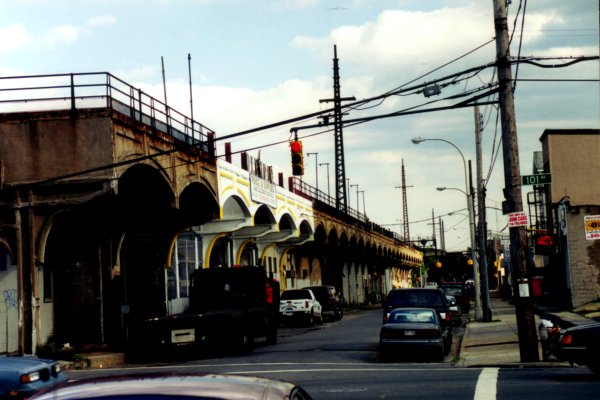
Above, the view southbound of the elevated Ozone Park
Station at 101st Avenue of the long defunct Long Island Railroad Rockaway Line Dead Tracks.
While the platform level is every bit the dead in Dead Track, at street
level the elevated structure is still very much alive, if understandably
seedy looking.
A host of parts suppliers and similar rust-belt type
operations are firmly ensconced in the dank warrens nestled beneath the platform.
This station hails from the beginning of the great
depression, so perhaps it was destined to a depressing life, if the word
life can even be used. It was the first elevated station going south towards
the Rockaways. The next two stations before Rockaway are raised platform, at
Aqueduct Raceway, and surface level, at Broad Channel, both living integral
parts of the NYC subway system sine 1956, as are the elevated stations in
Rockaway proper. The Rockaway elevated section and its stations are concrete
faced like the short Ozone Park elevated section, albeit with more of a
Mission style flavor.
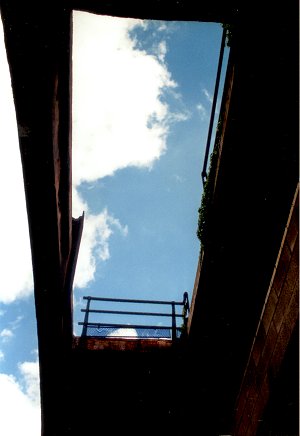
Ozone Park is the last dead stop on the Dead Tracks
before they stop being Dead Tracks. A block to the south, just a bit past
the end of the ghostly platform, the Rockaway bound subway splits off from
the Liberty Avenue elevated and merges into the only part of the Rockaway
Line to be offered a job when the LIRR began to abandon it in stages
following a disastrous fire that wiped out the old wooden viaduct carrying
the tracks across Jamaica Bay. The Transit Authority acquired the Rockaway
Line south of Liberty Avenue for a song from the bankrupt LIRR, rebuilt the
viaduct and connected the tracks south of Liberty to the subway system in
1956. Six years later, the truncated line north of Liberty was shut down.
While the Rockaway Line Ozone Park station may still give
good shelter to the scrap iron and hubcap industry, it does not give good
staircase. Above to the left is one of the ghost stairwells. For those who find
there way to the platform level, great care must be taken to avoid falling
through to the street, as nothing exists up there to prevent stupidity.
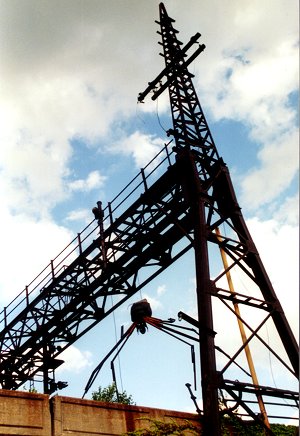
Here dangles the famous Ozone Park scrap metal
spider from one of the derelict overhead signal spans. This ingenious piece
of art could of, and should of, been made the center focus point of an
aggressive tourism push; it certainly earned the status of a tourist
attraction.
However, the MTA kingpins who have so visibly cared
for, nurtured, endowed, beautified and maintained the Rockaway Line
infrastructure over the past 40 years, decided that the spider was either
inappropriate, or dangerous, and at the very least, unauthorized. Subsequently, at some point between when I shot this in June 2000, and this writing in Spring
2004, the not-so-itsy bitsy spider came down the water spout for keeps, and
never returned.
Of course, it might have simply fallen. It certainly didn't
look like much was holding it up, but conspiratorial as my thinking process
tends to be, I'd much rather cast malevolent intentions on the heartless and
negligent public authority that holds the life and death of our mass transit
facilities in their grasping, graft and corruption stained, public-be-damned
hands.
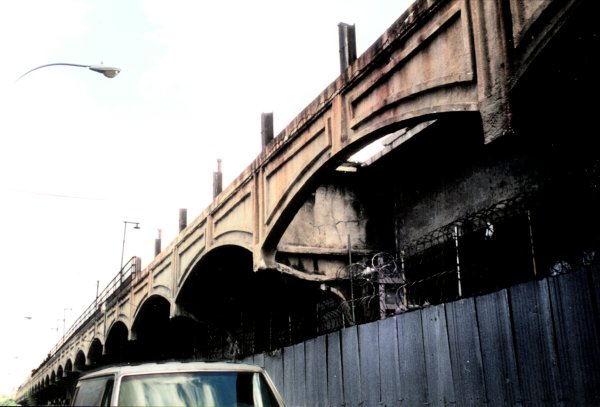
The scene on the northbound side is hardly as inviting to
the curious as the southbound side, which at least has businesses fronting
on it. Here we are limited to the backsides of those businesses, with their
requisite corrugated fences and barbed wire.
The business immediately to the
right has the benefit of a built-in skylight/sunroof thanks to the missing
stairwell. A few of the 1930 vintage platform light fixtures still survive
on both sides; wondrous escapees from the normally voracious scrap metal
thieves that usually pick such abandoned structures clean within a short
period of their closure.
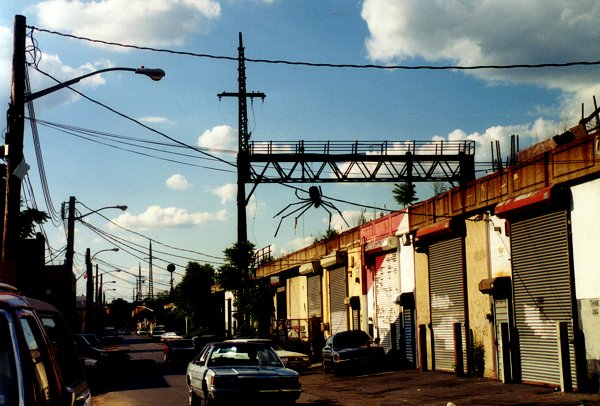
They may be ugly as sin, with their unadorned fronts and
security shutters, but they're still somebody's babies. It was late
in the afternoon on a lazy summer weekend and most of the scrappers and
jobbers are home barbequing.
If this station was converted to a
church, the overhead signal tower would make a wild church spire. It already
has the cross. I think it was used for signals, but what do I know? If
anyone knows otherwise, please write me, as I've noted other signals planted
by the track-side, such as the lollypop-like thing in the distance just
before the next cross-bar.

